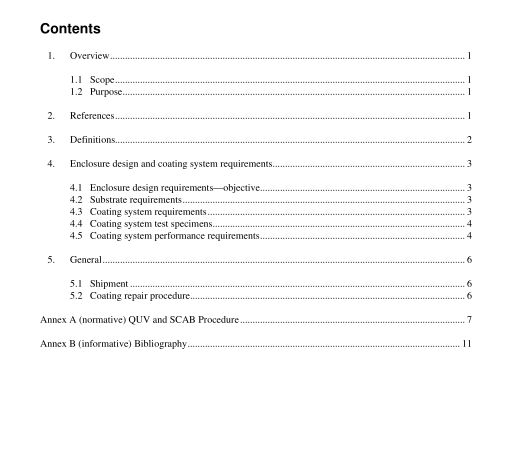IEEE C57.12.31-2002 pdf download.IEEE Standard for Pole Mounted Equipment—Enclosure Integrity
3. Denitions For the purposes of this standard, the following terms and denitions apply. IEEE 100 [B12] should be refer- enced for terms not dened in this clause.
3.1 carbon steel: A steel containing only residual quantities of elements other than carbon, except those added for deoxidation or to counter the deleterious effects of residual sulfur. Silicon is usually limited to about 0.60%, and manganese to about 1.65%. Also termed plain carbon steel, ordinary steel, straight carbon steel (see Bringas and Wayman [B11]).
3.2 conformance tests: Certain performance tests are conducted to demonstrate compliance with the appli- cable standards. The test specimen is normally subjected to all planned routine tests prior to initiation of the conformance test program.
—The conformance tests may, or may not, be similar to certain design tests. Demonstration of margins (capabili- ties) beyond the standard requirements is unnecessary.
3.3 design tests: Tests made by the manufacturer to determine the adequacy of the design of a particular type, or model of equipment, or its component parts to meet its assigned ratings and to operate satisfactorily under normal conditions and under special conditions if specied. These tests may be used to demonstrate compliance with applicable standards of the industry.
NOTE—Design tests, sometimes called type tests, are made on representative apparatus or prototypes to verify the validity of design analysis and calculation methods and to substantiate the ratings assigned to all other apparatus of basi- cally the same design. These tests may also be used to evaluate the modication of a previous design and to ensure that performance has not been adversely affected.
Test data from previous similar designs may be used for current designs, where appropriate. Once made, the tests need not be repeated unless the design is changed so as to modify performance.
3.4 lm thickness: The thickness of any applied coating(s) measured after curing.
3.5 routine tests: Tests made for quality control by the manufacturer on every device or representative sam- ples, or on parts or materials as required to verify during production that the product meets the design specications and applicable standards.
NOTES 1—Certain quality assurance tests on identied critical parts of repetitive high-production devices may be tested on a planned statistical sampling basis. 2—“Routine tests” are sometimes called “production tests.”
4. Enclosure design and coating system requirements 4
.1 Enclosure design requirements—objective The objective of this section is to describe design and performance requirements for carbon steel pole- mounted enclosures. Other stringent performance requirements may be needed to ensure longeld life in special or coastal environments.
4.1.1 Accessibility The enclosure shall be designed such that all exterior surfaces are accessible for proper surface preparation and the application of a uniform amount of the coating materials. Additionally, all exterior surfaces of the enclosure shall be accessible for the purposes of inspection and maintenance of the enclosure over the life of the equipment.
4.1.2 Contaminant accumulation The enclosure shall be designed to shed water and minimize areas where corrosive elements can accumulate.
4.1.3 Welds—surface preparation All welds shall be treated to prepare the weld area and the heat affected zones for coating. Weld splatter shall be removed. All welds shall be made in accordance with appropriate industrial welding standards.
4.2 Substrate requirements The substrate shall be a material that, when coated or otherwise processed, will maintain the structural in- tegrity of the enclosure over the life of the apparatus.
4.3 Coating system requirements
4.3.1 General All coated surfaces on the exterior of the enclosure that may be exposed to the environments shall be capable of meeting the performance tests required by this standard.IEEE C57.12.31 pdf download.IEEE C57.12.31-2002 pdf download
IEEE C57.12.31-2002 pdf download

Leave a Reply